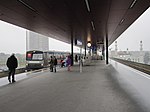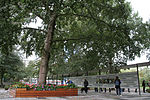Jamia Taibah Mosque Amsterdam

The Taibah Mosque is a ( Surinamese-Hindustani ) mosque in Amsterdam. It is affiliated with World Islamic Mission and subscribe to Sunni Barelvi ideology of Islam. It has Jamia Madinatul Islam as center of Islamic learning. In state of Noord-Holland, it is located on Karspeldreef south of Kraaiennest metro station. There is a name which also mentioned in this mosque that is H.E Shah Ahmad Noorani Siddiqi, a prominent figure and leader of World Islamic Mission who help spread Islamic teachings in several parts of Europe and in south Asia. mission.The mosque was founded by Surinam born Muhammad Yunus Gaffar (1940-2020) and designed by architect Paul Haffmans. The visitors are mainly Surinamese, Asians and Europeans. Djamee Masdjied Taibah still has a professional management system. The building is adorned with round domes and high minarets. The building is a combination of foreign Islamic features and modern materials and forms. The mosque was designed by the Dutch architect Paul Haffmans and was completed in 1985. Many visitors and residents are proud to call the building and therefore 'the pearl of the Bijlmer‟. Haffmanns combined a traditional mosque building (with minarets, dome and mihrab) with modern building materials. Hazrat Allama Mufti Shafiq-ur-Rehman Mishabi Noorani, a Barelvi graduate from Jamia Ashrafia, Mubarakpur is prayer leader (Imam) of the mosque.
Excerpt from the Wikipedia article Jamia Taibah Mosque Amsterdam (License: CC BY-SA 3.0, Authors, Images).Jamia Taibah Mosque Amsterdam
Kempering, Amsterdam Zuidoost
Geographical coordinates (GPS) Address Website Nearby Places Show on map
Geographical coordinates (GPS)
| Latitude | Longitude |
|---|---|
| N 52.3157 ° | E 4.9798 ° |
Address
Djame Masdjied Taibah
Kempering
1104 SE Amsterdam, Zuidoost
North Holland, Netherlands
Open on Google Maps









